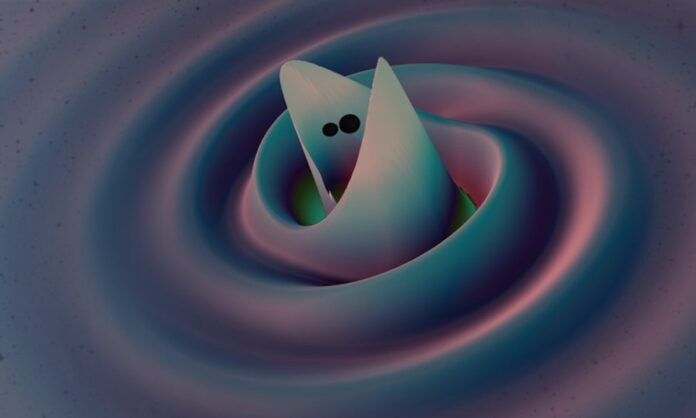They are mysterious, exciting and inescapable—black holes are some of the most exotic objects in the universe. With gravitational-wave detectors, it is possible to detect the chirp sound that two black holes produce when they merge, approximately 70 such chirps have been found so far.
A team of researchers at the Heidelberg Institute for Theoretical Studies (HITS) now predicts that in this “ocean of voices” chirps preferentially occur in two universal frequency ranges. The study has been published in The Astrophysical Journal Letters.
The discovery of gravitational waves in 2015—already postulated by Einstein 100 years ago—led to the 2017 Nobel Prize in Physics and initiated the dawn of gravitational-wave astronomy. When two stellar-mass black holes merge, they emit gravitational waves of increasing frequency, the so-called chirp signal, that can be “heard” on Earth. From observing this frequency evolution (the chirp), scientists can infer the so-called “chirp mass,” a mathematical combination of the two individual black hole masses.
So far, it has been assumed that the merging black holes can have any mass. The team’s models, however, suggest that some black holes come in standard masses that then result in universal chirps.
“The existence of universal chirp masses not only tells us how black holes form,” says Fabian Schneider, who led the study at HITS, “it can also be used to infer which stars explode in supernovae.” Apart from that it provides insights into the supernova mechanism, uncertain nuclear and stellar physics, and provides a new way for scientists to measure the accelerated cosmological expansion of the universe.
‘Severe consequences for the final fates of stars’
Stellar-mass black holes with masses of approximately 3–100 times our sun are the endpoints of massive stars that do not explode in supernovae but collapse into black holes. The progenitors of black holes that lead to mergers are originally born in binary star systems and experience several episodes of mass exchange between the components: in particular, both black holes are from stars that have been stripped off their envelopes.
“The envelope stripping has severe consequences for the final fates of stars. For example, it makes it easier for stars to explode in a supernova and it also leads to universal black hole masses as now predicted by our simulations,” says Philipp Podsiadlowski from Oxford University, second author of the study and currently Klaus Tschira Guest Professor at HITS.
The “stellar graveyard”—a collection of all known masses of the neutron-star and black-hole remains of massive stars—is quickly growing thanks to the ever-increasing sensitivity of the gravitational-wave detectors and ongoing searches for such objects. In particular, there seems to be a gap in the distribution of the chirp masses of merging binary black holes, and evidence emerges for the existence of peaks at roughly eight and 14 solar masses. These features correspond to the universal chirps predicted by the HITS team.
“Any features in the distributions of black-hole and chirp masses can tell us a great deal about how these objects have formed,” says Eva Laplace, the study’s third author.
Not in our galaxy: Black holes with much larger masses
Ever since the first discovery of merging black holes, it became evident that there are black holes with much larger masses than the ones found in our Milky Way. This is a direct consequence of these black holes originating from stars born with a chemical composition different from that in our Milky Way Galaxy. The HITS team could now show that—regardless of the chemical composition—stars that become envelope-stripped in close binaries form black holes of less than nine and greater than 16 solar masses but almost none in between.
In merging black holes, the universal black-hole masses of approximately nine and 16 solar masses logically imply universal chirp masses, i.e. universal sounds.
“When updating my lecture on gravitational-wave astronomy, I realized that the gravitational-wave observatories had found first hints of an absence of chirp masses and an overabundance at exactly the universal masses predicted by our models,” says Fabian Schneider. “Because the number of observed black-hole mergers is still rather low, it is not clear yet whether this signal in the data is just a statistical fluke or not.”
Whatever the outcome of future gravitational-wave observations: the results will be exciting and help scientists understand better where the singing black holes in this ocean of voices come from.
Reference:
Fabian R. N. Schneider et al, Bimodal Black Hole Mass Distribution and Chirp Masses of Binary Black Hole Mergers, The Astrophysical Journal Letters (2023). DOI: 10.3847/2041-8213/acd77a
